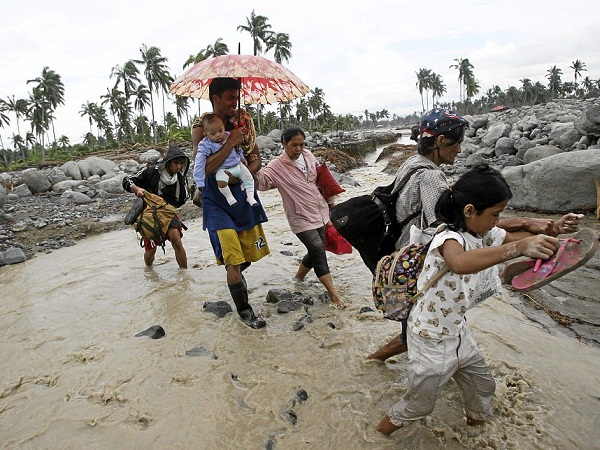
NEW RIVER Families cross a new river formed after Typhoon “Pablo” swept this area in New Bataan, Compostela Valley, Tuesday. INQUIRER/ MARIANE BERMUDEZ
NEW BATAAN, Compostela Valley—A new “river” as wide as the highway belt Epifanio de los Santos Avenue (Edsa) in Metro Manila has sprung up here, indicating the watery fury of Typhoon “Pablo” has forever altered the landscape of this remote mining and farming town.
As the mud settled and receded into the many water channels crisscrossing the town, dazed villagers were shocked to find how the terrain had changed the morning after the typhoon hit on Tuesday.
What used to be a field of coconut trees and wooden houses in Purok (zone) 4 had turned into a gushing river flanked by rocks and boulders that had tumbled down the mountain.
“That river? It was not there before. Those rocks? All those came from the mountain,” Sebastian Mandantes, a resident of neighboring Camanlangan village, said in Cebuano.
“There is no name for that river yet,” he said when asked what the channel was called.
The rushing stream of water, according to residents, had “branched out” from another river named Calyawan at the height of Pablo’s wrath in the mountainous village of Andap, the most severely hit in the town of 45,000 people, and from which most of the more than 220 who died in the typhoon lived.
Coconut and banana grower Genovevo Valencia, 48, said Calyawan had become so swollen it unleashed a great torrent of water that stripped the topsoil, dislodged large rocks, and swept virtually all of Andap away, carrying people, trees and debris.
The muddy torrent finally crashed into the settlements below, depositing bodies from the village on the slope and felling coconut trees that looked like snapped twigs by the side of the “riverbank” the next day.
Some of the coconut trees were bent unnaturally, as though bowing toward the northwest, the very same path Typhoon Pablo had taken as it cut across Mindanao, a place thought to be safe from storms until December 2011 when Tropical Storm “Sendong” ravaged northern Mindanao and the Visayas, especially Cagayan de Oro and Iligan cities.
Pablo followed Sendong’s act on about the same date. It was the strongest typhoon to hit the Philippines this year, with more than 400 dead, 101 of them in New Bataan, and damaging at least P4 billion in agriculture and property.
Bodies here and there
On Friday morning, the new river in New Bataan was still flowing strong, as deep as a man’s waist and as wide or wider in places like Edsa in Metro Manila. Search-and-rescue teams were still at work, retrieving bodies that turned up here and there.
The river stretched as far as the eye could see, and villagers believed it was flowing into one of the many tributaries of Agusan River to the north.
For Feliciano and Alejandra Medrano, a couple in their late 60s living in Purok 8, an adjacent hillside community, it was a river of horrors.
“That river brought the dead from Barangay (village) Andap to our barangay,” Alejandra said. Only two people in their neighborhood died, but their community was distraught to find so many corpses in their midst.
In New Bataan, 127 people have been recorded as dead as of mid-Friday, and 398 remained missing, according to a tally at the municipal gym in the town center. Most of the 71 identified dead came from Andap.
The Medrano couple narrated their ordeal.
At about 6 a.m., a neighbor shouted at them to evacuate to higher ground, as their small wooden house did not seem like it could withstand the typhoon raging outside.
When they got out of the door, they saw that the floodwater was already high. The Medranos tried to cross to the other side to join their neighbors.
“We were locked in an embrace. But the water was too strong. We were swept away,” Alejandra said.
She recalled pulling her husband up each time he went underwater. Feliciano, who was using a stick as a cane, said he had arthritis, which made it difficult for him to wade through the flood with its strong current.
Chapel refuge
Alejandra said they eventually managed to pull themselves out of the water’s way and joined their neighbors in a chapel, where they lay huddled and waited the storm out.
As the current was still too strong, the villagers spent four days in the chapel, subsisting on rice and banana, with kerosene lamps to illuminate the place at night.
They collected water from a ground spring and rationed the modest provisions among themselves.
“We didn’t want to leave because we at least had bananas, and we knew that there wasn’t a lot of food in the evacuation centers,” their neighbor, Leticia Galo, 43, said.
But eventually, food and gas ran out, their cell phone batteries gave out, and many in the group had to make the difficult trek to the town center to look for food, medicines and fuel.
They also worked together to gather the decomposing bodies.
Feliciano said about 50 people still crammed the chapel, a couple of whom were too old to cross the new river, and many children too young to do so.